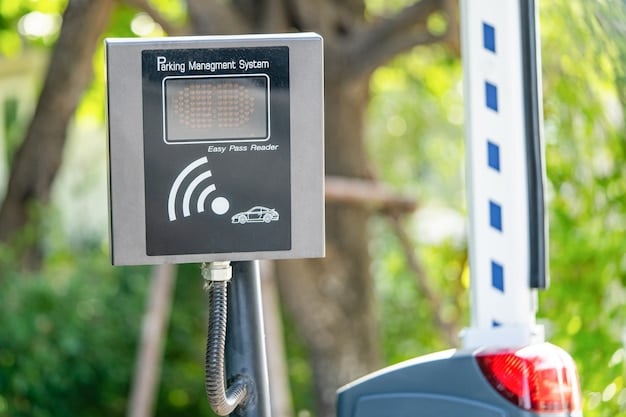Latest US Government Incentives for Electric Vehicles: Impact on Sales

The latest US government incentives for electric vehicle (EV) adoption include tax credits, rebates, and grants aimed at lowering the initial cost and encouraging consumers and businesses to switch to EVs, significantly influencing EV sales.
The automotive industry is undergoing a massive transformation with the rise of electric vehicles (EVs). A key factor influencing this shift is the array of latest government incentives for electric vehicle adoption in the US and how do they affect sales. These initiatives aim to make EVs more accessible and affordable, thereby boosting their sales and reducing carbon emissions to transition to clean energy goals.
Federal Tax Credits for Electric Vehicles
One of the most significant incentives for EV adoption is the federal tax credit. This credit aims to lower the upfront cost of purchasing an EV, making it more competitive with traditional gasoline-powered vehicles. Understanding the details of this credit is crucial for both consumers and manufacturers.
Understanding the Inflation Reduction Act
The Inflation Reduction Act of 2022 brought significant changes to the federal EV tax credit. It includes provisions that impact eligibility, credit amounts, and the types of vehicles that qualify. Let’s delve into the main points of this act.
How the Tax Credit Works
The federal EV tax credit can provide up to $7,500 in tax relief for eligible purchasers. However, there are several factors that determine the actual amount of the credit. Here are the key aspects:
- Income Limits: To be eligible, your modified adjusted gross income (MAGI) must not exceed certain thresholds: $300,000 for married filing jointly, $225,000 for heads of households, and $150,000 for single filers.
- Vehicle Requirements: The EV must be assembled in North America and meet specific battery component and critical mineral sourcing requirements.
- Credit Amount: The credit is calculated based on the vehicle’s battery capacity and sourcing, with a base amount plus additional amounts for meeting certain requirements.
The federal tax credit is a powerful tool to encourage EV adoption, but it also has limitations that potential buyers need to consider. Meeting the income and vehicle requirements is essential to claiming the full credit.

State and Local Incentives for EVs
In complement to federal incentives, many states and local governments offer their own programs to encourage EV adoption. These incentives can significantly reduce the overall cost of owning an EV. Let’s explore the state and local initiatives.
Types of State and Local Incentives
State and local governments employ various strategies to incentivize EV purchases. These incentives can take the form of rebates, tax credits, and other financial benefits. Here are some common types:
- Rebates: Direct financial rebates offered at the point of sale or after purchase can lower the upfront cost of an EV.
- Tax Credits: Similar to federal tax credits, state tax credits reduce your state tax liability.
- HOV Lane Access: Allowing EVs to use high-occupancy vehicle (HOV) lanes, even with a single occupant, can save time and reduce commute stress.
- Charging Infrastructure Support: States and cities often provide grants and rebates for installing EV charging stations at homes, workplaces, and public locations.
Examples of State Programs
Several states have implemented notable programs to promote EV adoption. For instance, California offers rebates through the Clean Vehicle Rebate Project (CVRP), while Massachusetts provides incentives through the MOR-EV program.
State and local incentives play a crucial role in making EVs more attractive to consumers, complementing federal efforts and accelerating the transition to electric mobility.
Impact of Incentives on EV Sales
Government incentives have a direct and measurable impact on EV sales in the United States. By reducing the cost barrier and providing additional benefits, these incentives drive consumer demand and accelerate market growth. This impact can be seen on the sales numbers and changing consumer behavior.
Direct Impact on Sales Volume
When incentives are available, more consumers are willing to consider purchasing an EV. This increased interest translates directly into higher sales volumes. Especially in areas with strong incentives, the impact is clear on sales metrics.
Changes in Consumer Behavior
Incentives can also shift consumer perceptions and preferences. When EVs become more affordable thanks to tax credits and rebates, they become a more viable option for a broader range of buyers. Moreover, incentives like HOV lane access and charging infrastructure support enhance the overall ownership experience, making EVs even more attractive.
The impact of government incentives on EV sales is undeniable. By lowering costs and improving the ownership experience, these programs are essential for driving the growth of the EV market in the US.

Challenges and Future of EV Incentives
While current incentives have proven effective, challenges remain in the path toward a fully electrified transportation sector. Overcoming these challenges and adapting incentives to better meet market needs will be crucial for continued success. The current trajectory of incentives may have to change soon.
Eligibility and Availability
Some incentives have strict eligibility requirements that limit their reach. For example, income caps and vehicle sourcing rules can exclude many potential buyers. Efforts to streamline these requirements and make incentives more widely available are crucial.
Long-Term Sustainability
As EV adoption increases, incentive programs may need to evolve to remain sustainable. Government budgets are not unlimited, and as more people claim credits and rebates, funding may become stretched. Exploring alternative funding models and strategies for phasing out incentives gracefully will be important.
Addressing these challenges and adapting incentive programs to meet the evolving needs of the EV market will be critical for ensuring the long-term success of electric vehicle adoption in the US.
The Role of Infrastructure in EV Adoption
While financial incentives can make purchasing an EV more attractive and accessible, the availability of charging infrastructure is equally critical to accelerate electric vehicle adoption. Federal, state, and local governments incentives for charging infrastructure are crucial for boosting sales across the United States. The current status of charging station availability is a hot topic.
Government Support for Charging Infrastructure
Recognizing this need, the U.S. government set a goal to build a national network of 500,000 EV chargers. Several programs and initiatives at the federal, state, and local levels support this goal through grants, rebates, and partnerships with private companies.
Types of Charging Infrastructure Incentives
Here are some incentives driving expansion of the EV charging infrastructure:
- Grants and Rebates: Governments and utilities offer grants and rebates to businesses, municipalities, and individuals for expenses such as purchasing and installing charging stations.
- Tax Credits: Tax credits are available for businesses and individuals who invest in EV charging equipment.
- Expedited Permitting: To lower costs and speed up construction, some states and localities have streamlined the process for permitting and installing EV charging stations.
How do Incentives Vary Across Different States?
Incentives for EVs are not uniform across the United States. The incentives available in one state can differ significantly from those in another. These variations can affect a consumer’s decision to purchase an EV. It’s important to be aware of all these variations.
Examples of State-Specific Programs
Here are some examples of how incentives vary between states:
- California:
- Clean Vehicle Rebate Project (CVRP): Offers rebates for eligible new electric vehicles, plug-in hybrid electric vehicles, and fuel cell vehicles.
- Clean Fuel Reward: Provides an instant reward at the point of sale or lease for eligible new electric vehicles.
- Colorado:
- Innovative state income tax credit for electric vehicle purchases.
- Rebates for installing EV charging stations.
- Massachusetts:
- MOR-EV (Massachusetts Offers Rebates for Electric Vehicles): Offers rebates for eligible new electric vehicles.
These variations in state EV incentive programmes and their impact on sales emphasize the significance of local government involvement in pushing EV adoption, and provide potential EV purchasers with insights into the possible financial benefits.
| Key Point | Brief Description |
|---|---|
| 💰 Federal Tax Credit | Offers up to $7,500 for eligible EV purchases, influenced by income and vehicle requirements. |
| 🌎 State Incentives | Include rebates, tax credits, and HOV lane access, varying significantly by state. |
| 📈 Sales Impact | Incentives boost EV sales by lowering initial costs and enhancing ownership benefits. |
| 🔌 Infrastructure | Government supports charging infrastructure with grants and tax credits, aiming for 500,000 chargers. |
Frequently Asked Questions
▼
The maximum federal tax credit for electric vehicles is $7,500. However, the actual amount depends on the vehicle’s battery capacity and compliance with sourcing requirements.
▼
Yes, there are income limits. To qualify, your modified adjusted gross income (MAGI) must not exceed $300,000 for joint filers, $225,000 for heads of households, and $150,000 for single filers.
▼
Yes, in many cases, state incentives can be combined with the federal tax credit, further reducing the cost of an EV. Check your state’s specific rules for eligibility.
▼
You can claim the federal EV tax credit when you file your federal income tax return. You’ll need to fill out IRS Form 8936 and submit it with your tax return.
▼
Yes, the Inflation Reduction Act introduced a tax credit for used EVs. It provides a credit of up to $4,000 for eligible used electric vehicles.
Conclusion
Government incentives play a vital role in promoting EV adoption in the US by reducing costs, encouraging infrastructure growth, and shaping consumer behavior. By understanding the types of incentives available, eligibility requirements, and their impact on the market, potential EV buyers can make informed decisions and contribute to a cleaner transportation future.





